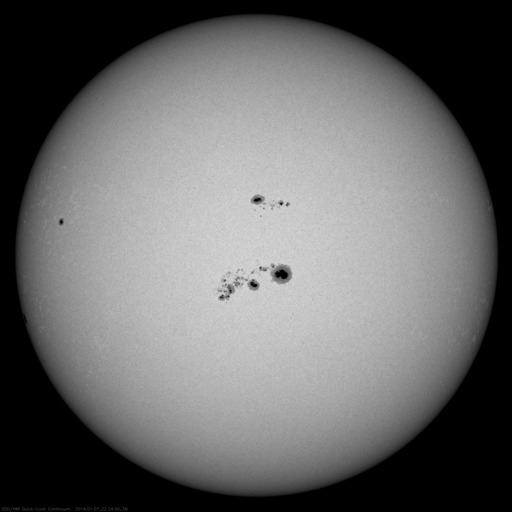"Monster sunspot AR1944 was directly facing Earth when this region on the
sun released an X-flare on January 7[, 2014]." Image Source: NOAA NWS Space Weather
Prediction Center via EarthSky.
An X-level solar storm is the most intense class of explosion on our star. On 7 January 2014, an X1.2 flare peaked at 1:32 p.m. EST (18:32 UTC). A coronal mass ejection exploded from a sunspot the size of our planet and the sun was facing earth when it occurred (Hat tip: Spaceports). This means that particles from the sun will collide with gas particles in our atmosphere today and tomorrow; the American National Weather Service is predicting a G3 (strong) geomagnetic storm. We will likely see the northern lights or Aurora Borealis down to lower-than-usual latitudes on January 9 and 10.
EarthSky reports on where and when to look for the northern lights:
A powerful flare on the sun on January 7, 2014 has created conditions possibly favorable to auroras at lower-than-usual latitudes, beginning at midday (UTC) on Thursday, January 9. Translate to your time zone here. For us in the United States, that means you should look outside on the morning of January 9, between midnight and dawn. If you’re clouded out at that time, try anytime during the night of January 9-10. The NOAA NWS Space Weather Prediction Center wrote on its Facebook page a few hours ago:
CME on the way…Want to see the northern lights?
We have completed initial analysis of the CME [coronal mass ejection] associated with today’s X1 … solar flare from Region 1944 (center disk) and have developed a forecast for a geoeffective event. Despite the CME not coming directly at Earth, a partial impact to the magnetic field that protects Earth is expected and a resulting geomagnetic storm as high as G3 (strong) levels is forecast to begin early to midday (UTC) on Thursday, 9 January (just after midnight early morning hours EST). Approximately 130 days of G3 conditions occur every 11 years, so this isn’t something out of the ordinary – though it has been a while.
If you don’t mind getting up early and have few to no clouds in your area overnight, you may get a chance to see the aurora if you live in the northern lower 48.
Image Source: Tower Prep.
Short term aurora forecast for 8 January 2014, click on the NOAA link for coming days. Image Source: NOAA.
Short term aurora predictions for 8 January 2014. Image Source: NOAA.






















No comments:
Post a Comment